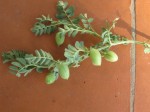The holiday of Shavuoth is fast approaching – a festival which was celebrated in the Old Testament days to mark the wheat harvest. Specifically, the tribes of Israel were mandated to take the first sheaves of the harvest and bring them as a sacrificial offering to the Temple in Jerusalem. The term for this offering in Hebrew is “bikurim”, which roughly means, first born or by extension – first to ripen.
But what happens when a plant has two different stages of ripening? Take wheat for example. Wheat can be fully ripe but still green – at which point it can be a very flavorful snack eaten raw (think of Jesus and his disciples in the wheat field), or even more flavorful when roasted (think Ruth and Boaz on the threshing floor).
But what I’m thinking about these days is chickpeas! The chickpeas are now green and ripe and it’s a celebration in the Arab communities in these parts. Eating green chickpeas straight from the stalk is a favorite snack – in Kfar Manda this weekend I saw kids who had set up a stand on the side of the street – just like I used to do when I sold lemonade – although they were selling stalks of chickpeas.
They are lovely raw, but I’ve also heard of them being soaked in salt water, or roasted in olive oil and salt.
I just came back from the chickpea field below our house and here is what I found. Within days they will all be brown and dry, and the chickpea inside will be dry and hard – just like they’re sold in the store.
Have you ever seen a chickpea plant?



Abbie, we saw chickpeas sold on the stalks in Morocco! They were street food. There are tons of chickpeas in the markets in Jerusalem right now, but you can’t find them for your life in Tel Aviv.
I think that any snack food that requires some kind of un-shelling has added value – forcing you to appreciate it more because of the effort invested. And when you crack open that outside husk to get to the chick pea inside, it makes such a satisfying pop!